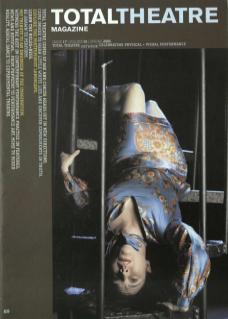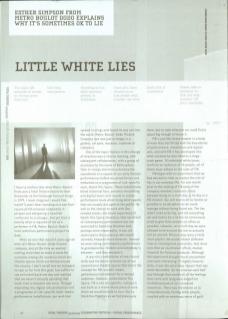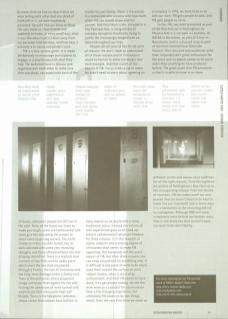One box, one person.
Entering a box with another person is forbidden.
Once you have chosen your box please wait outside the door.
Each box is numbered.
Please take a moment to tick the box number off your checklist.
You will then be instructed to enter your chosen box.
Once inside your experience will last exactly three minutes.
Please comply with any verbal or written instructions you are given once inside the box.
After 3 minutes you will be asked to leave.
You will then have 28 seconds of music to choose your next box.
The procedure will be repeated a further 13 times until every box has been visited.
There is no correct order. But never enter the same box twice.
I have to confess that when Metro-Boulot-Dodo won a Total Theatre Award for Best Newcomer at the Edinburgh Festival Fringe in 1999, I never imagined I would find myself five years later standing on a two-foot square plinth encased completely in perspex and whispering a heartfelt confession to a stranger. And yet that is exactly what is required of me as a performer in Fib, Metro-Boulot-Dodo's most ambitious performance project to date.
When we won that award five years ago we were still Metro-Boulot-Dodo theatre company, and at the time we wanted nothing more than to make a name for ourselves among the numerous black box theatre spaces which are dotted around the country. I don't recall how we managed to veer so far from this goal, but suffice to say we looked back one day and realised that we weren't actually spending that much time in theatres any more. Through expanding into digital arts production and a programme of site-specific multimedia performance installations, our work had spread its wings and found its way out into the world. Metro-Boulot-Dodo Theatre Company was now just as happy in a gallery, car park, museum, coalmine or cathedral.
One of the major factors in this change of direction was a chance meeting, and subsequent collaboration, with a group of musicians by the name of Bathysphere. Their lo-tempo electronica become the soundtrack to a couple of our early theatre performances before we joined forces and embarked on a programme of site-specific work, Watch This Space. These installations blend historical fact, personal storytelling and digital music and visuals to create performance tours which bring alive spaces that are usually not open to the public. As well as the chance to work with like-minded artists, the whole experience of Watch This Space showed us that our brand of contemporary performance was not restricted to black box theatres and, perhaps more importantly, it was not restricted to the audiences who would normally frequent those theatres. Instead we were taking contemporary performance to grandparents, children and everybody in between – and they enjoyed it.
It was this combination of newfound skills and the desire to break out of our conventional theatre spaces that led to the concept for Fib: a multimedia performance installation for a limited audience. However, unlike Watch This Space, Fib is not site-specific; instead it was built as a stand-alone piece of work which we would be able to tour. Not to black box theatres as we had previously done, but to take wherever we could find a space big enough to house it.
Fib is just the latest chapter in a body of work that has flirted with the boundaries of performance, installation and digital arts, and with Fib it has developed into what can best be described as a large-scale game. Fourteen individual white boxes confront on audience of fourteen people, all of whom must adhere to the rules of Fib.
Fib began with an experiment that we had devised to help us explore the role of lies in our everyday life. For one month prior to the making of Fib each of the company members randomly chose between being on a truth day, a lie day or a Fib mission. Our aim was to be as honest as possible or as deceptive as we could manage without being found out. The lies didn't need to be big, and not everything we said had to be a lie but we consciously tried to give false answers as often as possible. Likewise, on a truth day we were allowed to be evasive but not to actually tell an untruth. Mission days were a little more playful. We would inhabit different lives as investigative journalists, test drive cars that we could never afford, market research for fictional products. Although the experiment brought much amusement and some interesting (if slightly bizarre) data, it was the secondary impact that was most noticeable. By the time we were half way through that month all of the feelings that came with lying were magnified tenfold because of our increased awareness. There was the elation at so comprehensively fooling other people, coupled with an enormous sense of guilt.
By week three we had no idea if what we were telling each other had any shred of truth left in it, we were hopelessly paranoid. Up until now our close working life also made us close friends and suddenly we knew, in some small way, what it was like when trust is taken away from our personal relationships, and how easy it actually is to abuse somebody's trust.
Fib is a very serious game. It is made deliberately to encourage participants to engage in a playful way with what they find. The audience have to discuss and negotiate with each other to make sure that everybody can experience each of the 14 boxes, otherwise people are left out in the cold. Many of the boxes are there to make you laugh, some are confessional and some give the anonymity for people to share some surprising secrets. The toilet (made to mimic a public toilet) has its walls adorned with some very revealing thoughts and fears offered without the fear of being identified. There is a triptych that consists of two films and an audio piece which chart the lies that are passed through a family, the loss of innocence and the long-term damage within a family unit. There is the performer whose projected image ruthlessly interrogates his live self, forcing the admission of inner turmoil and weaknesses that are usually kept well hidden. There is the telephone salesman whose career frustrations have led him to murder his own family. There is the woman in a restaurant who wrestles with how much of her life she should share with her partner. And then there is me, encased in a tiny Perspex box, a living exhibit of everyday deception frantically trying to justify the increasingly tangled web we weave throughout our lives.
People tell all sorts of lies for all sorts of reasons. We don't claim to understand all of these reasons and in three minutes it would be foolish to delve too deeply into each example. And that is part of the beauty of Fib. For us it was a joy to make. We didn't need to worry about agreeing on every aspect as we would with a more traditional piece. Instead the volume of mini experiences gave us all (and our artistic collaborators) absolute freedom for three minutes. It is this breadth of styles, subjects and a varying degree of seriousness that seems to make Fib appealing. Not everybody will like every aspect of Fib, but after three minutes you can swap around and try something new. It is difficult in any piece of work to do much more than scratch the surface of one's subject matter, what is more of an achievement, and what Fib seems to have done, is to get people talking. We see the work more as a catalyst for conversation than a life changing experience, but ultimately Fib seems to do two things which, from the very first show we made as a company in 1996, we have tried to do with our work. Fib gets people to talk, and Fib gets people to smile.
So far, Fib, has been presented as part of the Now festival in Nottingham, by Phoenix Arts in a car park in Leicester, at MACBA in Barcelona, as part of X.trax in Manchester and in a disused shop as part of Stockton International Riverside Festival. Non-arts and arts audiences alike have responded with great enthusiasm for the piece and its appeal seems to be much wider than anything we have produced before. The great asset that Fib possesses is that it is able to move in so many different circles and always raise eyebrows for all the right reasons. From the highbrow art junkies of Nottingham's Now Festival to the unsuspecting shopper from the streets of Stockton, Fib has taken itself out and proved that art doesn't have to be kept in boxes (no pun intended) and in many ways it is a testament to the reasoning behind its conception. Although MBD will never completely leave behind our theatre roots, that is one black box that we don't want our work to be restricted by.
For more information on Fib and the work of Metro-Boulot-Dodo see: www.metro-boulot-dodo.com / www.whydowelie.com / www.watch-this-space.org.uk


